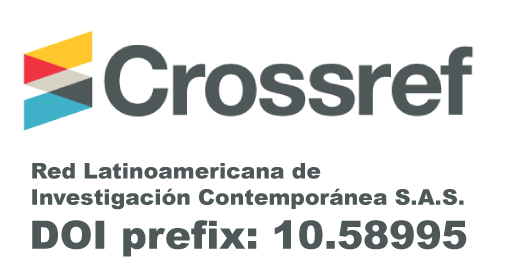Risk factors related to sleep bruxism in children andadolescents. A Scoping Review
Abstract
Introduction: sleep bruxism in children and adolescents is a multifactorial disorder that integrates genetic, emotional, physiological and environmental factors. Aim: to systematically map available studies on risk factors associated with sleep bruxism in children and adolescents. Methodology: This scoping review included 13 observational studies to systematically map risk factors related to bruxism. Eligibility criteria were articulated to the PCC framework (population, concept, context). Results: The influence of genetic predisposition, emotional stress, physiological conditions (such as gastro-oesophageal reflux) and socio-environmental variables such as family dynamics and exposure to electronic devices are highlighted. In addition, disparities were detected in subgroups, such as children with developmental problems or those influenced by recent social transformations, such as the COVID-19 pandemic. Conclusion: Hereditary susceptibility, neurological abnormalities, emotional stress and inadequate sleep environments are among the most important determinants. Despite advances in the understanding of this disorder, significant gaps remain in the literature, in terms of longitudinal research and specific subpopulations.
Downloads
References
- Herrera M, Valencia I, Grant M, Metroka D, Chialastri A, Kothare S V. Bruxism in Children: Effect on Sleep Architecture and Daytime Cognitive Performance and Behavior. Sleep [Internet]. septiembre de 2006;29(9):1143–8. https://doi.org/10.1093/sleep/29.9.1143 DOI: https://doi.org/10.1093/sleep/29.9.1143
- Castelo PM, Barbosa TS, Gavião MBD. Quality of life evaluation of children with sleep bruxism. BMC Oral Health [Internet]. el 14 de diciembre de 2010;10(1):16. https://doi.org/10.1186/1472-6831-10-16 DOI: https://doi.org/10.1186/1472-6831-10-16
- Ommerborn MA, Özbek A, Grunwald M, Depprich RA, Walentek NP, Franken M, et al. Effects on general pain perception and dental pulp sensibility in probable sleep bruxism subjects by experimentally induced pain in a pilot study. Sci Rep [Internet]. el 10 de abril de 2023;13(1):5836. https://doi.org/10.1038/s41598-023-33019-z DOI: https://doi.org/10.1038/s41598-023-33019-z
- Luco K. Sleep Related Bruxism, Headaches and Cardiovascular Diseases. Sleep [Internet]. el 29 de mayo de 2023;46(Supplement_1):A310–A310. https://doi.org/10.1093/sleep/zsad077.0706 DOI: https://doi.org/10.1093/sleep/zsad077.0706
- Lei Q, Lin D, Liu Y, Lin K, Huang W, Wu D. Neuromuscular and occlusion analysis to evaluate the efficacy of three splints on patients with bruxism. BMC Oral Health [Internet]. el 25 de mayo de 2023;23(1):325. https://doi.org/10.1186/s12903-023-03044-5 DOI: https://doi.org/10.1186/s12903-023-03044-5
- Serra-Negra JM, Paiva SM, Ramos-Jorge ML, Flores-Mendoza CE, Pordeus IA. Association between stress, personality traits and sleep bruxism in children: a population-based case-control study. J Epidemiol Community Heal [Internet]. el 1 de agosto de 2011;65(Suppl 1):A147–A147. https://doi.org/10.1136/jech.2011.142976e.84 DOI: https://doi.org/10.1136/jech.2011.142976e.84
- Liu J, Ji X, Rovit E, Pitt S, Lipman T. Childhood sleep: assessments, risk factors, and potential mechanisms. World J Pediatr [Internet]. el 28 de febrero de 2024;20(2):105–21. https://doi.org/10.1007/s12519-022-00628-z DOI: https://doi.org/10.1007/s12519-022-00628-z
- Emodi-Perlman A, Shreiber-Fridman Y, Kaminsky-Kurtz S, Eli I, Blumer S. Sleep Bruxism in Children—What Can Be Learned from Anamnestic Information. J Clin Med [Internet]. el 29 de marzo de 2023;12(7):25–64. https://doi.org/10.3390/jcm12072564 DOI: https://doi.org/10.3390/jcm12072564
- Alqaderi H, Abdullah A, Finkelman M, Abufarha M, Devarajan S, Abubaker J, et al. The relationship between sleep and salivary and serum inflammatory biomarkers in adolescents. Front Med [Internet]. el 26 de mayo de 2023;10(May):1–13. https://doi.org/10.3389/fmed.2023.1175483 DOI: https://doi.org/10.3389/fmed.2023.1175483
- Tricco AC, Lillie E, Zarin W, O’Brien KK, Colquhoun H, Levac D, et al. PRISMA Extension for Scoping Reviews (PRISMA-ScR): Checklist and Explanation. Ann Intern Med [Internet]. el 2 de octubre de 2018;169(7):467–73. https://doi.org/10.7326/M18-0850 DOI: https://doi.org/10.7326/M18-0850
- Gonçalves LPV, Toledo OA, Bezerra ACB, Leal SC. Variables associated with bruxism in children and adolescents. ConScientiae Saúde. 2009;8(3):397–403. https://doi.org/10.5585/conssaude.v8i3.1706 DOI: https://doi.org/10.5585/conssaude.v8i3.1706
- Serra-Negra JM, Paiva SM, Auad SM, Ramos-Jorge ML, Pordeus IA. Signs, symptoms, parafunctions and associated factors of parent-reported sleep bruxism in children: A case-control study. Braz Dent J. 2012;23(6):746–52. https://doi.org/10.1590/S0103-64402012000600020 DOI: https://doi.org/10.1590/S0103-64402012000600020
- Ferreira-Bacci A do V, Cardoso CLC, Díaz-Serrano KV. Behavioral problems and emotional stress in children with bruxism. Braz Dent J. 2012;23(3):246–51. https://doi.org/10.1590/S0103-64402012000300011 DOI: https://doi.org/10.1590/S0103-64402012000300011
- de Souza VAF, Abreu MHNG, Resende VLS, de Castilho LS. Factors associated with bruxism in children with developmental disabilities. Braz Oral Res. 2015;29(1):1–5. https://doi.org/10.1590/1807-3107BOR-2015.vol29.0009 DOI: https://doi.org/10.1590/1807-3107BOR-2015.vol29.0009
- Meyer Prado I, Oliveira Brant M. Sleep Bruxism and Orthodontic Appliance among Children and Adolescents: A Preliminary Study. J Sleep Disord Ther. 2016;05(02). https://doi.org/10.4172/2167-0277.1000238 DOI: https://doi.org/10.4172/2167-0277.1000238
- Sousa HCS, De Lima M de DM, Neta NBD, Tobias RQ, De Moura MS, Moura L de FA de D. Prevalence and associated factors to sleep bruxism in adolescents from Teresina, Piauí. Rev Bras Epidemiol. 2018;21:1–11. https://doi.org/10.1590/1980-549720180002 DOI: https://doi.org/10.1590/1980-549720180002
- Laganá G, Osmanagiq V, Malara A, Venza N, Cozza P. Sleep bruxism and sdb in albanian growing subjects: A cross-sectional study. Dent J. 2021;9(3):1–9. https://doi.org/10.3390/dj9030025 DOI: https://doi.org/10.3390/dj9030025
- De Almeida AB, Rodrigues RS, Simão C, de Araújo RP, Figueiredo J. Prevalence of Sleep Bruxism Reported by Parents/Caregivers in a Portuguese Pediatric Dentistry Service: A Retrospective Study. Int J Environ Res Public Health. 2022;19(13). https://doi.org/10.3390/ijerph19137823 DOI: https://doi.org/10.3390/ijerph19137823
- De Lima LCM, Leal TR, de Araújo LJS, Sousa MLC, da Silva SE, Serra-Negra JMC, et al. Impact of the COVID-19 pandemic on sleep quality and sleep bruxism in children eight to ten years of age. Braz Oral Res. 2022;36:1–8. https://doi.org/10.1590/1807-3107BOR-2022.VOL36.0046 DOI: https://doi.org/10.1590/1807-3107bor-2022.vol36.0046
- Bahammam HA. Validation of Sleep Bruxism Questionnaire Toward the Experience of Jaw Pain and Limitation of Jaw Movement in Saudi Arabian Adolescents. Cureus. 2022;14(6). https://doi.org/10.7759/cureus.26120 DOI: https://doi.org/10.7759/cureus.26120
- Marceliano CRV, Gavião MBD. Possible sleep bruxism and biological rhythm in school children. Clin Oral Investig [Internet]. 2023;27(6):2979–92. https://doi.org/10.1007/s00784-023-04900-y DOI: https://doi.org/10.1007/s00784-023-04900-y
- Kumar KM, Reddy VR, Nandini AK, Chowdhary N. Systemic Condition Associated with Bruxism- A Case Report. Asian J Pediatr Res. 2023;13(2):1–5. https://doi.org/10.9734/ajpr/2023/v13i2254 DOI: https://doi.org/10.9734/ajpr/2023/v13i2254

Published 2025-04-05
Keywords
- factores de riesgo,
- bruxismo del sueño,
- niños,
- adolescentes ,
- revisión
Issue
Section
Copyright (c) 2025 Los autores que publiquen en la revista Multidisciplinaria Investigación Contemporánea aceptan los siguientes términos: 1. Los autores mantienen sus derechos de autor (copyright) y otorgan a la revista Multidisciplinaria Investigación Contemporánea el derecho de la primera publicación de su trabajo, bajo una licencia Creative Commons Attribution 4.0. Esta licencia permite que terceros utilicen el contenido publicado, siempre que se mencione la autoría y la primera publicación en esta revista. 2. Los autores pueden establecer acuerdos adicionales para la distribución no exclusiva de la versión publicada de su artículo en otros lugares, como repositorios institucionales, siempre y cuando se indique claramente que el trabajo fue publicado por primera vez en esta revista. 3. Los autores conservan sus derechos de autor (copyright) y garantizan a la revista Multidisciplinaria Investigación Contemporánea el derecho a publicar el manuscrito a través de los canales que considere apropiados. 4. Se permite y se recomienda a los autores compartir su trabajo en línea (por ejemplo, en repositorios institucionales o páginas web personales), una vez que el manuscrito haya sido aceptado para su publicación. Esto puede conducir a intercambios productivos y a una mayor y más rápida citación del trabajo publicado.

This work is licensed under a Creative Commons Attribution 4.0 International License.



















